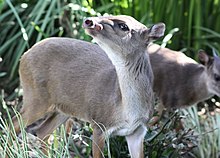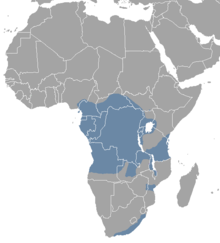
Back Blouduiker Afrikaans ديكر أزرق Arabic ديكر ازرق ARZ Putcuxol (Philantomba monticola) AVK Philantomba monticola Azerbaijani Син дукер Bulgarian Nkɔkunan BM Duiquer blau Catalan Philantomba monticola CEB Blå dykkerantilope Danish
| Blue duiker | |
|---|---|

| |
| Scientific classification | |
| Domain: | Eukaryota |
| Kingdom: | Animalia |
| Phylum: | Chordata |
| Class: | Mammalia |
| Order: | Artiodactyla |
| Family: | Bovidae |
| Genus: | Philantomba |
| Species: | P. monticola
|
| Binomial name | |
| Philantomba monticola (Thunberg, 1789)
| |

| |
| Distribution map of Blue duiker | |
| Synonyms | |
| |
The blue duiker (Philantomba monticola) is a small antelope found in central, southern and eastern Africa. It is the smallest species of duiker. The species was first described by Swedish naturalist Carl Peter Thunberg in 1789. 12 subspecies are identified. The blue duiker reaches 32–41 centimetres (13–16 in) at the shoulder and weighs 3.5–9 kilograms (7.7–19.8 lb). Sexually dimorphic, the females are slightly larger than the males. The dark tail measures slightly above 10 centimetres (3.9 in). It has short, spiky horns, around 5 centimetres (2.0 in) long and hidden in hair tufts. The subspecies show a great degree of variation in their colouration. The blue duiker bears a significant resemblance to Maxwell's duiker.
Activity is diurnal (limited to daytime). Secretive and cautious, the blue duiker confines itself to the forest fringes. Territorial, individuals of opposite sexes form pairs and occupy territories, nearly 0.4–0.8 hectares (0.0015–0.0031 sq mi) large and marked by preorbital gland secretions. The blue duiker feeds on fallen fruits, foliage, flowers and pieces of bark, provided mainly by the forest canopies in their habitat. The age when sexual maturity is gained has been given differently by different studies. The species is monogamous, with pairs remaining together throughout the year. The length of the gestational period has been estimated from as little as four months to as long as seven months. Births occur throughout the year, though the birth rate might fall in the dry season. The calf is mainly kept in hiding and weaning occurs at 2.5 to 3 months.
The habitat consists of a variety of forests, including old-growth, secondary, and gallery forests. Forests are preferred as these provide the animal with shelter through the dense understory and forage through the canopy. Though categorized as Least Concern by the International Union for Conservation of Nature and Natural Resources (IUCN), the blue duiker is under threat from extensive bushmeat hunting across its range.
- ^ IUCN SSC Antelope Specialist Group (2016). "Philantomba monticola". IUCN Red List of Threatened Species. 2016: e.T4143A50183103. doi:10.2305/IUCN.UK.2016-1.RLTS.T4143A50183103.en. Retrieved 19 November 2021.
- ^ "Appendices | CITES". cites.org. Retrieved 2022-01-14.
